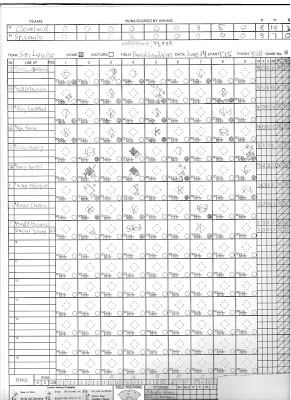
Just for fun, I tried using a variation of L.L. Bean’s scoring system for this game.
Unfortunately, I don’t have a lot of information on Bean’s system, only what was described by Paul Dickson in
The Joy of Keeping Score, which does very helpfully reproduce a sample game scored by Bean.
Bean stated that his system was designed for night-scoring; I guess maybe fans in the 1950s felt that the lighting was sub-standard and their scorebooks were harder to read for the new-fangled night games. It seems like an anachronism now to need or even entertain thoughts of having a special “night scoring” system.
Bean’s system did not note individual fielders at all; that was unacceptable for me, even for one game, so I included position numbers when they were necessary. Often, they are not; the vast majority of groundouts to second go 43, so I only wrote the numbers down when it was something more unusual, like 41. I also added symbols to indicate line drives or fouls instead of just flyouts, and of course I tracked baserunner advancement and pitch sequence, neither of which were in Bean’s system.
The basic symbol for an out in the system is an “O” or a circle. The location of dots or lines around the circle indicate which fielder made the play and whether the ball was hit in the air or on the ground. Rather than spelling out all of the details, I will go through the play-by-play for this game, and you should be able to figure out the basics yourself.
TOP 1
Sizemore singled to center.
Cabrera flied to right.
Hafner grounded to second; Sizemore to second.
Garko walked.
Peralta hit into fielder’s choice at third; Garko out 54 at second.
BOT 1
Buck flied to left.
Ellis flied to left.
Barton grounded to first.
TOP 2
Dellucci grounded to first.
Michaels doubled to left, line drive.
Marte flied to center.
Shoppach grounded to second.
BOT 2
MSweeney grounded to second, deflected by pitcher.
Brown lined to right.
Crosby grounded to short.
TOP 3
Sizemore grounded to first, pitcher covering.
Cabrera flied to left.
Hafner singled to third.
Garko popped to second in the outfield.
BOT 3
Hannahan grounded to first, pitcher covering.
Suzuki singled to center, line drive.
Suzuki advanced to second on passed ball; RSweeney singled to second, Suzuki to third.
Buck flied to left, sacrifice; Suzuki scored.
Ellis flied to right.
TOP 4
Peralta singled to left, line drive.
Dellucci struck out.
Michaels flied to center.
Marte hit into fielder’s choice at third; Peralta out 54 at second.
BOT 4
Barton flied to right.
MSweeney singled off third, groundball.
Brown popped to third.
Crosby hit into a fielder’s choice at short; MSweeney out 64 at second.
TOP 5
Shoppach struck out looking.
Sizemore lined to left.
Cabrera popped to short.
BOT 5
Hannahan struck out.
Suzuki singled to second.
RSweeney struck out looking.
Buck hit into fielder’s choice at short; Suzuki out 64 at second.
TOP 6
Hafner grounded to second.
Garko flied to center.
Peralta singled to center, groundball.
Dellucci flied to left.
BOT 6
Ellis struck out looking.
Barton struck out.
MSweeney fouled to first.
TOP 7
Michaels grounded to third.
Marte singled to right.
Shoppach singled to left; Carroll to second.
Sizemore walked; Shoppach to second, Carroll to third.
Cabrera grounded to first, pitcher covering; Sizemore to second, Shoppach to third, Carroll scored.
Hafner intentionally walked.
Garko walked; Hafner to second, Sizemore to third, Shoppach scored.
Peralta struck out.
BOT 7
Brown flied to warning track in left.
Crosby walked.
Hannahan lined to second.
Suzuki flied to right.
TOP 8
Gutierrez flied to left.
Michaels struck out.
Carroll popped to second in the outfield.
BOT 8
Cust struck out looking.
Buck grounded to first, pitcher covering.
Ellis flied to center.
TOP 9
Shoppach lined to right.
Sizemore walked.
Cabrera flied to left.
Hafner grounded to short, deflected by pitcher.
BOT 9
Barton struck out.
MSweeney walked.
Brown flied to center.
Crosby hit into fielder’s choice at third, Murphy out 54 at second.
If you are more of a visual person, I suppose you might enjoy this system. I am not, and I vastly prefer traditional numbers rather than drawing 54 circles every game. I tried it because I like to at least try scoring a game by most of the systems that I come across, just to say I did and to be able to offer semi-informed opinions on the merits of each system.
This is an excellent opportunity, then, to re-emphasize that scorekeeping is all about your own personal preferences. When I critique various scoring methods or scoresheet designs here, it is always from my own perspective. I do not in any way hold it up as “right” or the one true way or the “best” or anything of the such.
This will be important to keep in mind as the next few sheets I post will be from different scoring systems than what I generally use. I will be commenting on them in the spirit of the above paragraph, and if you disagree, I celebrate that. Scorekeeping is a pursuit where individuality should be flaunted.
For a brief word on the game, the Indians were able to scrap out a couple of runs in the seventh inning to win it 2-1. With the bases loaded and one out, Asdrubal Cabrera hit a grounder to first. While the sheet does not necessarily reflect it, Daric Barton rushed in his attempt to turn an inning-ending DP, and bobbled the ball. He was left with only a flip to first to get the out there, and the game was tied. The A’s intentionally walked Travis Hafner to load the bases, and Ryan Garko worked out of a 1-2 hole to draw a walk that would account for the game-winning run.










































